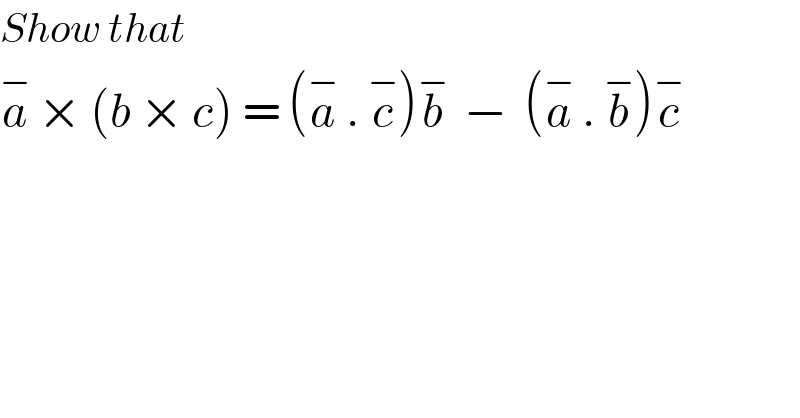
Question and Answers Forum
Question Number 6374 by sanusihammed last updated on 25/Jun/16

Commented by FilupSmith last updated on 25/Jun/16

Commented by prakash jain last updated on 25/Jun/16

Commented by FilupSmith last updated on 25/Jun/16
![note: t=<t_1 , t_2 , ..., t_g >= [(t_1 ),(t_2 ),(⋮),(t_g ) ], t∈R^g I will be using this notation for simplicity. a=<a_1 , ..., a_n > b=<b_1 , ..., b_n > c=<c_1 , ..., c_n > a,b,c∈R^n a×b=∥a∥∥b∥sin(θ)n → vector a•b=∥a∥∥b∥cos(θ) → scalar ∥t∥=(√(t_1 ^2 +t_2 ^2 +...+t_n ^2 )) → scalar where n is the unit vector perpendicular to a and b. Question: a×(b×c)=(a•c)b−(a•b)c because a•b and a•c are scalars, multiplying them by a vector makes a new vector. e.g. 5⟨2, 1⟩ = ⟨10, 5⟩ continue](Q6389.png)
| ||
Question and Answers Forum | ||
Question Number 6374 by sanusihammed last updated on 25/Jun/16 | ||
 | ||
Commented by FilupSmith last updated on 25/Jun/16 | ||
 | ||
Commented by prakash jain last updated on 25/Jun/16 | ||
 | ||
Commented by FilupSmith last updated on 25/Jun/16 | ||
![note: t=<t_1 , t_2 , ..., t_g >= [(t_1 ),(t_2 ),(⋮),(t_g ) ], t∈R^g I will be using this notation for simplicity. a=<a_1 , ..., a_n > b=<b_1 , ..., b_n > c=<c_1 , ..., c_n > a,b,c∈R^n a×b=∥a∥∥b∥sin(θ)n → vector a•b=∥a∥∥b∥cos(θ) → scalar ∥t∥=(√(t_1 ^2 +t_2 ^2 +...+t_n ^2 )) → scalar where n is the unit vector perpendicular to a and b. Question: a×(b×c)=(a•c)b−(a•b)c because a•b and a•c are scalars, multiplying them by a vector makes a new vector. e.g. 5⟨2, 1⟩ = ⟨10, 5⟩ continue](Q6389.png) | ||